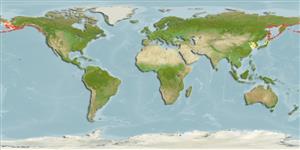Environment: milieu / climate zone / depth range / distribution range
Ecology
Marine; demersal; depth range 0 - 60 m (Ref. 50550). Temperate
North Pacific: off the Okhotsk coast of Hokkaido to the northern Sea of Japan and the Bering Sea.
Size / Weight / Age
Maturity: Lm ? range ? - ? cm
Max length : 13.0 cm TL male/unsexed; (Ref. 56557)
Short description
Identification keys | Morphology | Morphometrics
Common in the littoral zone at depths up to 30 m. Probably spawns in the littoral zone and its larvae and fry are transported to river estuaries in tides (Ref. 26949).
Life cycle and mating behavior
Maturity | Reproduction | Spawning | Eggs | Fecundity | Larvae
Robins, C.R., R.M. Bailey, C.E. Bond, J.R. Brooker, E.A. Lachner, R.N. Lea and W.B. Scott, 1991. Common and scientific names of fishes from the United States and Canada. Am. Fish. Soc. Spec. Publ. (20):183 p. (Ref. 3814)
IUCN Red List Status (Ref. 130435: Version 2024-1)
Threat to humans
Harmless
Human uses
Tools
Special reports
Download XML
Internet sources
Estimates based on models
Preferred temperature (Ref.
123201): 1 - 7.1, mean 2.9 °C (based on 414 cells).
Phylogenetic diversity index (Ref.
82804): PD
50 = 0.7500 [Uniqueness, from 0.5 = low to 2.0 = high].
Bayesian length-weight: a=0.00589 (0.00281 - 0.01234), b=3.15 (2.97 - 3.33), in cm total length, based on LWR estimates for this (Sub)family-body shape (Ref.
93245).
Trophic level (Ref.
69278): 3.5 ±0.53 se; based on food items.
Resilience (Ref.
120179): Medium, minimum population doubling time 1.4 - 4.4 years (Preliminary K or Fecundity.).
Fishing Vulnerability (Ref.
59153): Low vulnerability (10 of 100).
Nutrients (Ref.
124155): Calcium = 111 [43, 252] mg/100g; Iron = 0.42 [0.19, 0.96] mg/100g; Protein = 17.3 [15.0, 19.5] %; Omega3 = 0.638 [0.254, 1.788] g/100g; Selenium = 9.96 [4.19, 25.33] μg/100g; VitaminA = 32.2 [8.6, 110.7] μg/100g; Zinc = 0.866 [0.547, 1.514] mg/100g (wet weight);
